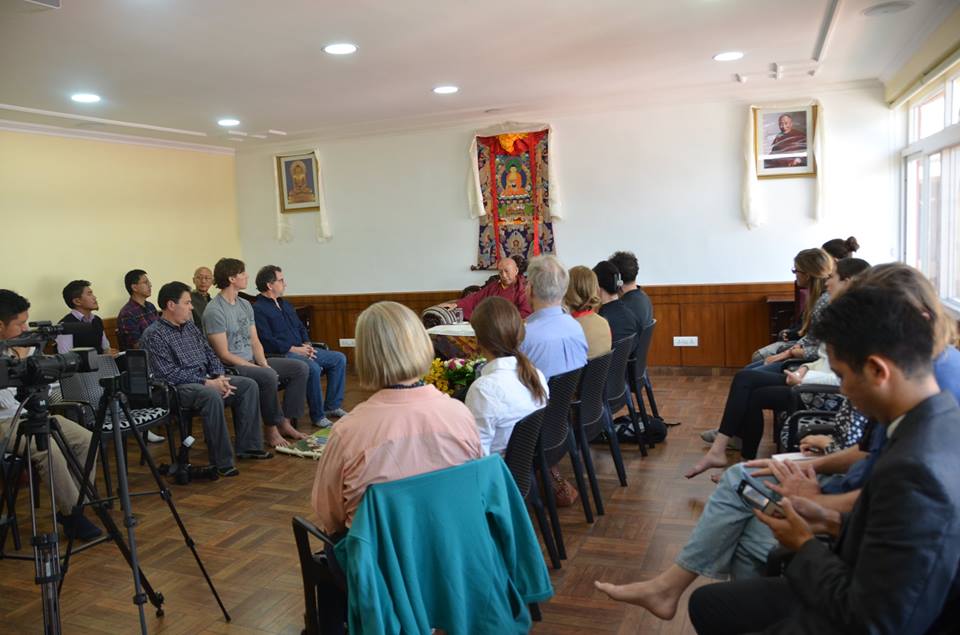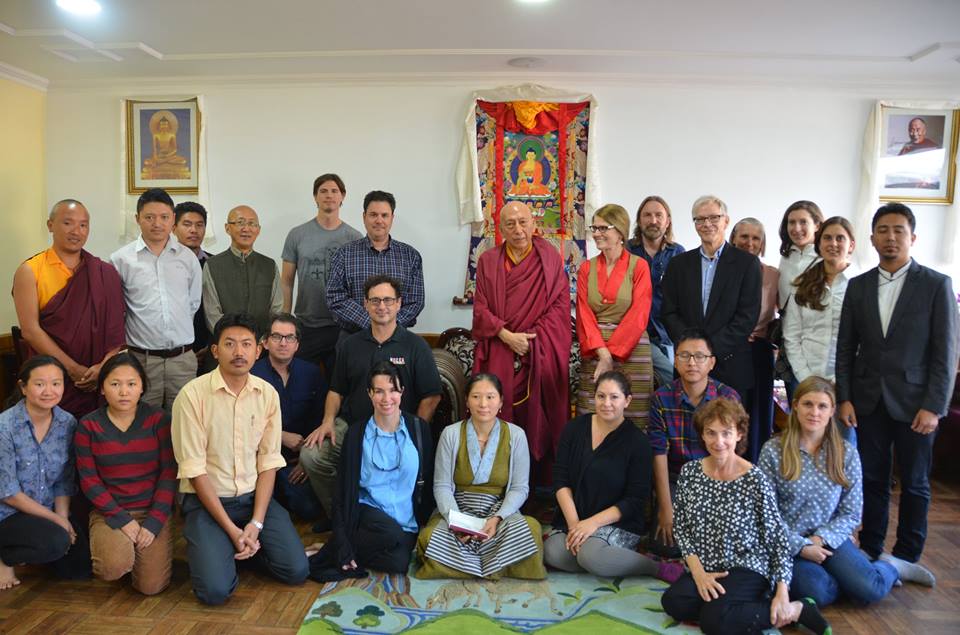“Mindfulness in Integrative Medical Practice—The Mind and Body Connection”
A Talk at the request of medical practitioners
23 October 2016
This morning His Eminence Prof. Samdhong Rinpoche gave a talk on the requested theme of “Mindfulness in Integrative Medical Practice—The Mind and Body Connection,” at the “East meets West: Mindful Medicine Conference” convened at Lha Ahimsa House’s Conference Room, Dharamshala.
The Conference was organised jointly by Lha Charitable Trust: Institute for Social Work & Education, Delek Hospital, Ochsner Hospitals of New Orleans, Tibetan Medical and Astrological Institute, Louisiana Mississippi Hospice & Palliative Care Organization and Louisiana Himalayan Association. Many medical practitioners (Doctors) from these institutes and hospitals attended the conference.
His Eminence Prof. Samdhong Rinpoche began the talk by pointing out the different notions of the word “mindfulness,” particularly in the modern society, and that in Buddhist context mindfulness is defined as the mind watching the mind in the present moment, which is very difficult thing to do.
With regards to the way how to treat patients with compassion by a medical practitioner, His Eminence continued:
Western packaged meditation on mindfulness is mainly aimed for relaxation of mind, where “mindfulness” refers to calming of an agitated mind, and integrate the scattered mind towards one-pointedness. Mindfulness refers also to awareness, doing things with awareness; it is also a difficult thing to do for an ordinary person, because our body, speech and mind are so conditioned that we do things as habit, not aware of them.
For a physician in looking after a patient the process is in three consecutive process of diagnosing the illness, what is the disease, and then what is the cause of it, the antidote to that cause;this is the approach of the Buddhist teachings of the four noble truths, applicable to all situations. Supressing of symptoms is not a treatment, treatment means to achieve the cure, and to achieve the cure the cause of the disease has to be removed; when the cause is removed the symptoms will cease automatically. With the removal of the cause of the disease the patient will achieve the freedom from the disease. So both the patient and the doctor have to be aware of the process towards recovery; if they go about things with habitual approach, there is the risk of mistakes and overlooking important things.
Treatment of patient by a good doctor requires a great deal of concentration, attentiveness, and from the patient’s part a good listening, and between the two a good communication.
The physician needs to carry the service not as a livelihood, rather out of concern for the patients. It must not be a profession of trade, or for making money. A situation where the patients become the means for business for the doctors and hospitals, the preventative measures of medicine becomes unimportant, patients become the market; in such situation the poor cannot receive good treatment and cannot access good doctors. In such situation the doctors become unmindful of their responsibility to cure the patient, irrespective of whether or not there is monetary earning from that. To treat all patients—rich or poor;all need to be treated as equal and equal attention should be given, this is a basic mindfulness necessary for a medical practitioner.
At a time when the medical care has become a kind of health industry, medical industry, it becomes that the aim is for enriching of the capital owners, it does not become a thing for the welfare of the poor, the patient. There the mindfulness goes towards trade, the mindfulness towards the patient completely disappears.
A compassionate mind, care for the patient—whosoever be—and the determination to treat the patient, notwithstanding whether or not the patient is able to pay the fees, such a mindset, such a mindfulness needs to be integrated into medical practice.
In defining “integrate” in the wordings of the topic requested, there is now compartmentalisation, or specialisation, which is also a feature of modern education system, where knowledge is very narrowed in, divided, and the holistic knowledge disappears. Also, with “body and mind” mentioned in the topic, the awareness of the relation between body and mind has disappeared. Compartmentalised treatment of the body, not of the whole body, has its risks; in the absence of holistic view of the whole body, when a compartmentalised part of body is treated, it can damage other parts of the body, such as, a treatment of one particular organ may cause damage to other organs, harms of this kind have occurred many times.
The last part of the topic, “mind and body connection”, is a difficult subject. The meaning of what Buddhists call “mind” and that of what science calls as “mind” are entirely different, although the same word is used. While the audience have a different notion of the word “mind” a dialogue may be difficult to take place. We need to define “mind” and “body.” For Buddhists, “mind” is an entirely different entity, which is formless, intangible, without beginning and end, perennially continues itself; it is as an energy of knowing, energy of clarity, continuous. Body is the vehicle used by that energy.
Carvaka’s (Charvaka) assertion of mind as the quality of the body is similar to modern science’s view of the two, that the body creates the mind and when the body disintegrates and disappears the mind too disappears, like wall and the painting on it. Similar to that, modern science describes the mind as activity of brain cells, and when the brain cells have gone the mind too goes.
Buddhist view of the mind is that the mind has been coming from past lives, and when this body disintegrates the mind goes on to next life. The connection between the body and the mind therefore is a bondage by karmic force. The body too is created by karmic force, by which the gathering of its materials, the four elements, come about. The four elements as the composites are common to all tangible things, things with form. The dichotomy is that although the four elements are non-complementary by nature with one another—fire and water, wind and earth—the wonderful fact is that they work complementarily and sustain the body; this becomes possible because of our past lives’deeds, past lives’ karmic force, with the mind as the main factor for the sustenance, that as long as the mind owns or resides in the body the body is functional and alive, the body becomes a dead body the moment the mind leaves it; once the mind has left the body, the body immediately decays and rots. Mind has ownership or control on the whole body. While there is no pain when an overgrown nail is cut, or hair is cut, but that there is pain when a finger is cut, is because there is the mind-body relationship. When something goes away from the reach of the mind, this relationship is not there. Apart from that, the entire body has the reach by the mind.
Therefore the freedom from diseases of the body largely depends on the mindset. A meditator can control many diseases without any medicine; the mindset or the control by mind can cure the illnesses. In the seventeenth century there was a great scholar Changkya Rolpai Dorje. In his forties he lost both his eyesight; then, he meditated to create an eye-organ in his fingers. After few months of meditation he achieved that and would read all the texts with his fingers—not the Braille, the plain letters. If one understands that kind of mind-body relationship and use the awareness, it can be useful for attaining freedom from many kinds of diseases.
His Eminence Rinpoche thereafter touched upon the complexity of the workings of the mind, by mentioning the aspects of the mind through its fifty-two mental factors, and how the ancient Indian schools, particularly the Buddhists have gained high development in the science of the mind.
His Eminence Prof. Samdhong Rinpoche continued: “To sum up, I would say that body and mind being interconnected, and inseparably bound till death by the past karmic force, many of body’s diseases may not be completely cured if mindset is not changed. Likewise, if the body is not kept in regularity, in balance, the balance of all its components, then that will affect the mind as well. So, the relationship is very subtle and very close one, which can affect each other very forcefully.
“For an integrated medical treatment there has to be the treatment together both the body and the mind, and to find the root cause of the disease, which may be sometimes in the body, sometimes in the mind, sometimes in both, and which is difficult to find out. If it is with both, then both should be treated; if the cause is with the mind, the mind should be treated. To treat the mind and the body together, and to find the root cause of the disease—that can be called ‘integrated medical practice.’”
At the end His Eminence remarked that the talk was an impromptu one, at the request of the organisers, and wished that the points may have parts that would be useful to the participants. There followed a number of Q/A.
The talk can be viewed below.


